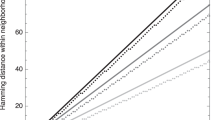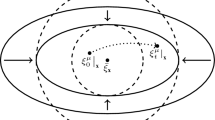Abstract
A simple model of a population of asexually reproducing individuals, evolving in a flat fitness landscape, is defined. It is shown that the model is equivalent to a dynamical system with stochastic dynamics, the Annealed Random Map Model. Thus, it is possible to solve exactly for the genealogy statistics and for the genetic variability of the population. Fluctuations of quantities, like the average relatedness and the variability, which also take place in the limit of an infinitely large population, are computed.
Similar content being viewed by others
Literature
Amitrano, C., L. Peliti and M. Saber. 1988. Neutralism and adaptation in a simple model of molecular evolution.C. R. Acad. Sci. Paris, Sér. III 307, 803–806.
Amitrano, C., L. Peliti and M. Saber. 1990. Population dynamics in a spin-glass model of chemical evolution.J. molec. Evol.,29, 513–525.
Biebricher, C. K. 1986. Darwinian evolution of self-replicating RNA.Chemica Scripta 26B, 51–57.
Demetrius, L., P. Schuster and K. Sigmund. 1985. Polynucleotide evolution and branching processes.Bull. math. Biol.,47, 239–262.
Derrida, B. 1980. Random-energy model—limit of a family of disordered systems.Phys. Rev. Lett. 45, 79–82.
Derrida, B. 1981. Random-energy model—an exactly solvable model of disordered systems.Phys. Rev. B24, 2613–2626.
Derrida, B. and D. Bessis. 1988. Statistical properties of valleys in the annealed random map model.J. Phys. A21, L509-L515.
Derrida, B. and H. Flyvbjerg. 1987. Statistical properties of randomly broken objects and of multivalley structures in disordered systems.J. Phys. A20, 5273–5288.
Ebeling, W. and R. Feistel. 1977. Stochastic theory of a molecular replication process with selection character.Ann. Phys. (Leipzig) 34, 81–90.
Eigen, M., J. McCaskill and P. Schuster. 1988. Molecular quasi-species.J. Phys. Chem. 92, 6881–6891.
Flesselles, J.-M. 1989. Contribution théorique à l'étude de la relaxation dans les verres de spin. Thèse, Université Paris-Sud.
Flesselles, J.-M. and R. Botet. 1989. Derivation of a stretched-exponential time relaxation.J. Phys. A22, 903–909.
Fontana, W., W. Schnabl and P. Schuster. 1989. Physical aspects of evolutionary optimization and adaptation.Phys. Rev. A40, 3301–3321.
Fontana, W. and P. Schuster. 1987. A computer model of evolutionary optimization.Biophys. Chem. 26, 123–147.
Hofbauer, J. and K. Sigmund. 1988.The Theory of Evolution and Dynamical Systems—Mathematical Aspects of Selection. Cambridge: Cambridge University Press.
Kauffman, S. A. 1989. Adaptation on rugged fitness landscapes. InComplex Systems. SFI Studies in the Science of Complexity, D. Stein(ed.), pp. 527–617. Reading, MA: Addison-Wesley.
Kauffman, S. A. and S. Levin. 1987. Towards a general theory of adaptive walks in rugged fitness landscapes.J. theor. Biol. 128, 11–45.
Kimura, M. 1983.The Neutral Theory of Molecular Evolution. Cambridge: Cambridge University Press.
Kimura, M. and J. F. Crow. 1964. The number of alleles that can be maintained in a finite population.Genetics 49 725–738.
Macken, C. A. and A. S. Perelson. 1989. Protein evolution in rugged fitness landscapes.Proc. natl Acad. Sci. U.S.A. 86, 6191–6195.
Mézard, M., G. Parisi and M. A. Virasoro. 1987.Spin-Glass Theory and Beyond. Singapore: World Scientific.
Nowak, M. and P. Schuster. 1989. Error thresholds of replication in finite populations.J. theor. Biol. 137, 375–395.
Schuster, P. and K. Sigmund. 1985. Dynamics of evolutionary optimization.Ber. Bunsenges. phys. Chem. 89, 668–682.
Schuster, P. and J. Swetina. 1988. Stationary mutant distribution and evolutionary optimization.Bull. math. Biol. 50, 635–660.
Stewart, F. M. 1976. Variability in the amount of heterozygosity, maintained by neutral mutations.Theor. Pop. Biol. 9, 188–201.
Swetina, J. and P. Schuster. 1982. Self-replication with errors—a model for polynucleotide replication.Biophys. Chem. 16, 329–345.
Weinberger, E. 1987. A model of natural selection that exhibits a dynamic phase transition.J. stat. Phys. 49, 1011–1028.
Wright, S. 1937. The distribution of gene frequencies in populations.Proc. natl Acad. Sci. U.S.A. 23, 307–320.
Zhang, Y.-C., M. Serva and M. Polikarpov. 1990. Diffusion-reproduction processes.J. stat. Phys., in press.
Author information
Authors and Affiliations
Rights and permissions
About this article
Cite this article
Derrida, B., Peliti, L. Evolution in a flat fitness landscape. Bltn Mathcal Biology 53, 355–382 (1991). https://doi.org/10.1007/BF02460723
Received:
Revised:
Issue Date:
DOI: https://doi.org/10.1007/BF02460723




